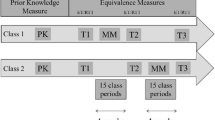Abstract
Inversion is a fundamental relational building block both within mathematics as the study of structures and within people’s physical and social experience, linked to many other key elements such as equilibrium, invariance, reversal, compensation, symmetry, and balance. Within purely formal arithmetic, the inverse relationships between addition and subtraction, and multiplication and division, have important implications in relation to flexible and efficient computation, and for the assessment of students’ conceptual understanding. It is suggested that the extensive research on arithmetic should be extended to take account of numerical domains beyond the natural numbers and of the difficulties students have in extending the meanings of operations to those of more general domains. When the range of situations modelled by the arithmetical operations is considered, the complexity of inverse relationships between operations, and the variability in the forms that these relationships take, become much greater. Finally, some comments are offered on the divergent goals and preoccupations of cognitive psychologists and mathematics educators as illuminated by research in this area.
Similar content being viewed by others
References
Berliner, D. C. (2002). Educational research: The hardest science of all. Educational Researcher, 31(8), 18–20.
Conway, J. H., & Guy, R. K. (1996). The book of numbers. New York: Springer.
De Corte, E., Greer, B., & Verschaffel, L. (1996). Mathematics teaching and learning. In D. C. Berliner & R. C. Calfee (Eds.), Handbook of educational psychology (pp. 491–549). New York: Macmillan.
De Corte, E., & Verschaffel, L. (1987). The effect of semantic structure on first graders’ strategies for solving addition and subtraction word problems. Journal for Research in Mathematics Education, 18, 363–381.
De Morgan, A. (1910). Study and difficulties of mathematics. Chicago: University of Chicago Press [Originally 1831].
Fischbein, E., Deri, M., Nello, M. S., & Marino, M. S. (1995). The role of implicit models in solving verbal problems in multiplication and division. Journal for Research in Mathematics Education, 16(1), 3–17.
Freudenthal, H. (1983). Didactical phenomenology of mathematical structures. Dordrecht: Reidel.
Freudenthal, H. (1991). Revisiting mathematics education. Dordrecht: Kluwer.
Fuson, K. C. (1992). Research on whole number addition and subtraction. In D. A. Grouws (Ed.), Handbook of research on mathematics teaching and learning (pp. 243–275). New York: MacMillan.
Greer, B. (1992). Multiplication and division as models of situations. In D. A. Grouws (Ed.), Handbook of research on mathematics teaching and learning (pp. 276–295). New York: Macmillan.
Greer, B. (1994). Extending the meaning of multiplication and division. In G. Harel & J. Confrey (Eds.), The development of multiplicative reasoning in the learning of mathematics (pp. 61–85). Albany: SUNY Press.
Greer, B. (2009). Helping children develop mathematically. Human Development, 52, 148–161.
Greer, B., & Harel, G. (1998). The role of isomorphisms in mathematical cognition. Journal of Mathematical Behavior, 17(1), 5–24.
Greer, B., & Mangan, C. (1986). Understanding multiplication and division: From 10-year-olds to student teachers. In L. Burton & C. Hoyles (Eds.), Proceedings of the tenth international conference for the psychology of mathematics education (pp. 25–30). London: London Institute of Education.
Greer, B., & Verschaffel, L. (1990). Introduction to the special issue on mathematics as a proving ground for information-processing theories. International Journal for Educational Research, 14, 3–12.
Harel, G., Behr, M., Post, T., & Lesh, R. (1994). The impact of the number type on the solution of multiplication and division problems: Further considerations. In G. Harel & J. Confrey (Eds.), The development of multiplicative reasoning in the learning of mathematics (pp. 363–384). Albany: SUNY Press.
Kilpatrick, J. (1981). The reasonable ineffectiveness of research in mathematics education. For the Learning of Mathematics, 2(2), 22–29.
Lakoff, G., & Nunez, R. E. (2000). Where mathematics comes from: How the embodied mind brings mathematics into being. New York: Basic Books.
Maher, C. A., Powell, A. B., & Uptegrove, E. B. (2010). Combinatorics and reasoning: Representing, justifying, and building isomorphisms. New York: Springer.
Piaget, J. (1969). The child’s conception of number. London: Routledge & Kegan Paul [Originally 1941].
Siegler, R. S., & Stern, E. (1998). Conscious and unconscious strategy discoveries: A microgenetic analysis. Journal of Experimental Psychology. General, 127, 377–397.
Urton, G. (1997). The social life of numbers: A Quechua ontology of numbers and philosophy of arithmetic. Austin: University of Texas Press.
Van den Heuvel-Panhuizen, M. (1996). Assessment and realistic mathematics education. Utrecht: Utrecht University.
Vergnaud, G. (2009). The theory of conceptual fields. Human Development, 52, 83–94.
Wertheimer, M. (1982). Productive thinking. Chicago: University of Chicago Press [Originally 1945].
Author information
Authors and Affiliations
Corresponding author
Rights and permissions
About this article
Cite this article
Greer, B. Inversion in mathematical thinking and learning. Educ Stud Math 79, 429–438 (2012). https://doi.org/10.1007/s10649-011-9317-2
Published:
Issue Date:
DOI: https://doi.org/10.1007/s10649-011-9317-2




